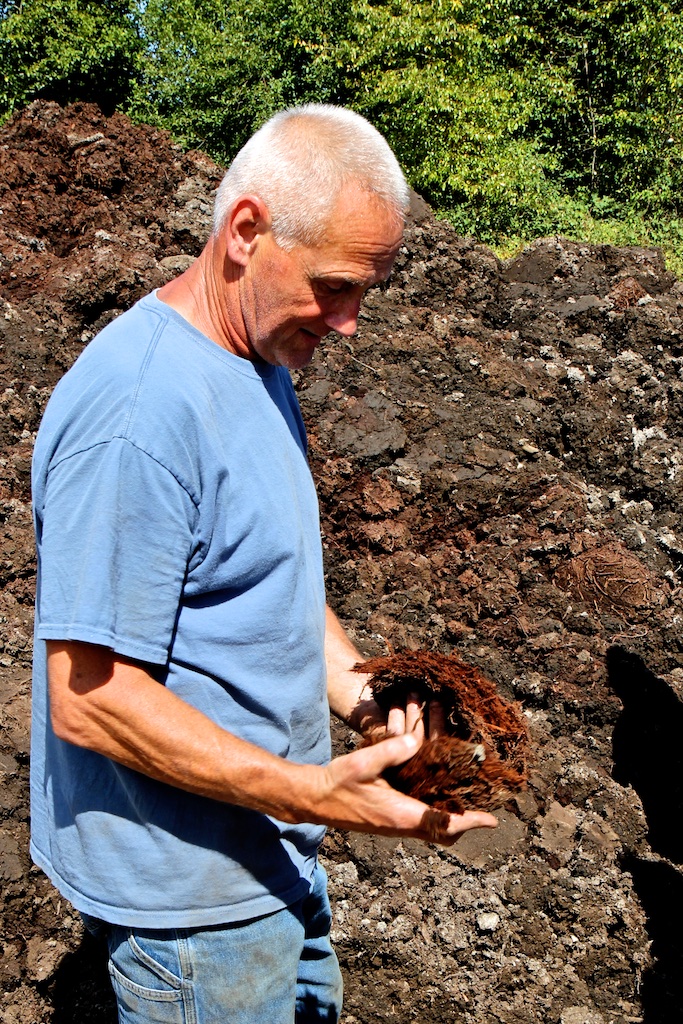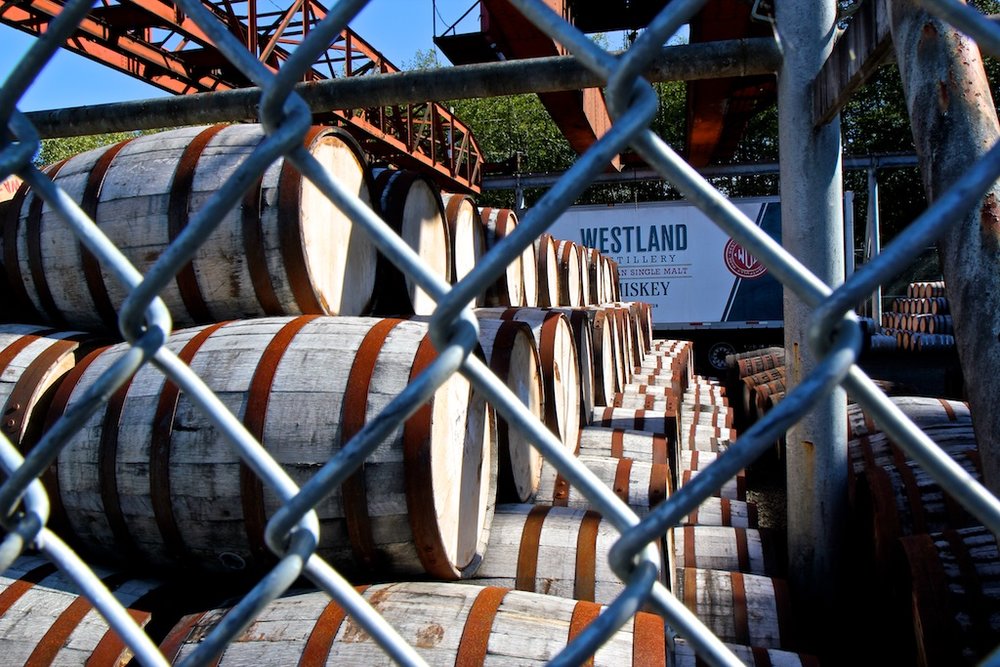Westland Distillery: Day 3 – The Building Blocks of Industry

Being from California, I consider my state the spirtual home of the old west, the final destination for the entrepreneurial pioneers who headed West in search of gold. However, as I was reminded yesterday at Filson, the Pacific Northwest had its own spell of gold fever and Seattle’s industries at the time adapted to meet that impending influx of mountain men and the remnants of that era are still actively at work. When thinking of today’s technological boom, I suffer from the same sort of tunnel vision. I work right smack in the middle of Silicon Valley. I’m more than aware of what’s happening with continued expansion, population increases, and all of the headaches that come with that progression, but I forget that it’s happening elsewhere, too. Apparently, Seattle’s traffic has become an absolute nightmare due to the increase in population, and as Amazon expands its central campus, along with new developments from Expedia and Facebook, the city is racing to create more affordable housing in response. Much like San Francisco, Seattle is changing, adapting, and modifying itself in response to these pioneers of the new frontier. It’s in the middle of this transition that Emerson Lamb looks to add Westland to the modern age of Seattle’s industry leaders.

We began our third day with a ferry ride west, across Elliott Bay to Bremerton. Due to my many journeys to Islay—the mecca of single malt production off the western coast of Scotland—taking the ferry is something I naturally associate with whisky. It made complete sense that we would travel by boat to visit a Washington peat bog. Ferries and peat bogs go hand-in-hand in my mind.

We hit land at the Bremerton dock and began the drive southwest to a small town called Shelton, where the Wright Brothers own a company called Organic Solutions, specializing in nursery, lawn, and garden needs—including peat moss. Behind the main building is a dusty path that leads to a six acre pond, created especially by Westland and Organic Solutions for the harvesting of local Washington peat.

What strikes you immediately about Islay—and really Scotland in general—are the colors. It’s all browns, greens, dark blues, and dark grays. With the exception of the timber, Western Washington shares much of that same natural color pattern. There’s a similarity in the feel of both locales—the cool breeze coming off the ocean, the moisture in the air, and the brooding darkness looming beyond the horizon.

Let’s talk about peat for a minute (because not all peat is equal). Because the structure of peat depends on the decomposition of vegetable matter and minerals, the deeper down you cut into the earth, the more the composition of the peat itself begins to change. Top-cut peat, for example—the peat that’s closest to the surface level—is less broken down, and therefore less dense. When burned, it releases strong phenolics and it catches fire easily due to its more-fibrous structure. Most of what’s harvested for malting purposes is top-cut peat, dug out in rows along the surface of the Scottish bogs. Hence: many Islay whiskies carry the stronger, phenolic aromas and flavors from that matter.

What Westland is beginning to do, however, is very different from any other producer I’m aware of. They’re using a tractor to dig much deeper into the earth (up to thirty-five feet under the lake); extracting both middle-cut and bottom-cut peat as well, then separating the three groups to create a variety of peat options. When ignited, middle-cut peat creates a much milder smoke, whereas bottom-cut peat—with its incredibly-dense composition—burns slower and cooler, releasing lighter aromas and heathery notes. Using strictly the high temperatures of top-cut peat to dry one’s barley can have adverse consequences, however, such as damaging the structure and integrity of the barley itself. What Westland is looking to do is blend various cuts of peat to combine the slow-burning, cooler flame of the bottom-cut peat with some of the more-flavorful compounds of top-cut peat to increase the absorption of smoke, while creating a more dynamic set of aromatics and flavor. Emerson and Matt are every bit as serious about the many possibilities of peat blending as they are about every other factor of their whisky production. It’s mind-boggling how deep they’re willing to go in the name of better booze (in this case, both literally and figuratively, with a "bog" pun thrown in for good measure).

Upon leaving the bog, we continued west towards the coast and the town of Aberdeen—famous for being the home of Nirvana frontman Kurt Cobain (and the subject of the new HBO documentary Montage of Heck). Immediately next to Aberdeen, is the adjacent town of Hoquiam—the hometown of Emerson Lamb and the seat of his family’s industry empire. If you weren’t already aware, the Lambs are a bit like the Hearsts of the Pacific Northwest. As you drive through Aberdeen and into Hoquiam, you travel down Emerson Street—and, no, that’s not a coincidence. The name Lamb is ascribed to the side of numerous factory buildings; more and more often as you get closer to the Westland warehousing.

The Westland rackhouse and bottling line are closer to the ocean than appears; so close, in fact, that they sit on top of a rocky landfill in what was once part of the sea itself. There are two main warehouses, both dunnage style, neither of which are temperature controlled. Again, Emerson is committed to the idea of Westland as a distinctly Washingtonian single malt. Much like the aforementioned whiskies from Islay—aged near the sea and shaped by the salty island winds—he wants the rainy, maritime climate of Hoquiam to influence the flavors of Westland’s ultimate profile. If you thought Seattle was rainy, it’s got nothing on Hoquiam.

There are a lot of casks at Westland’s Hoquiam facility; much more than I had previously imagined. Like I've mentioned before, Westland is not some rinky-dink little stab at creating a single malt whiskey company. Emerson lobbied his family’s business with its ample funds and deep pockets to go all in with this project—either everything or nothing. If Westland fails, it won’t be for lack of trying. I think you have to visit to really comprehend the level of commitment here. This is truly America’s first serious single malt whiskey operation. No one else is even close.

Tasting from the cask is always fun. It’s always an insight into the purest of possible samples.

And then it was time to visit Westland—no, not the distillery, but rather the original Westland: the Lamb family estate, high upon the hill overlooking the town. The name of the distillery is Westland because the story of Westland begins here, in this very manor. While Emerson and Matt run and operate the day-to-day logistics of the Westland whiskey company, the business itself belongs to Enterprises International—the various interests and trusts behind the original Lamb magnates, still operated today by Emerson's family. The Westland estate is where that story begins, and the property itself is spellbinding. It's everything you think it will be when Emerson tells you about his childhood.

Take a bit of Wes Anderson’s Royal Tennenbaums and combine it with Fitzgerald’s Great Gatsby and you’ll begin to understand Emerson Lamb and his family’s legacy. Westland is filled with artifacts from around the world, a vast library with original copies of anthropological books and travelogues from the 19th century, and various treasures that have a fascinating history beyond the likes of anything I’ll ever own. Adventuring seems to be innate in the family blood. His mother had just flown in from Europe—a quick jaunt through Croatia and Montenegro. There are manifests from various expeditions all over the main study. I wouldn't have been at all surprised if Emerson had told us he had to leave later that evening to go grizzly bear hunting in Alaska. I didn't think people like this existed in real life. I thought it was purely the childhood fantasy of Jacques Cousteau nostalgia a la Steve Zissou, but it's here and it's happening.

But if we're talking about Gatsby, and Emerson is indeed the new-world version of Howard Hughes, his presence is never decadent, ostentatious, or off-putting. Emerson Lamb is only in his mid-twenties, yet he shows the maturity, mannerisms, and determination of someone much older. At over six feet tall, he's a powerful, sturdy figure. He talks exactly like Johnny Depp, so much so that I would sometimes close my eyes and see if I could pretend it was him. He's captivating, mysterious, and magnetic—all signs pointing to his pre-determined destiny as the Lamb family's latest mogul and the American whiskey industry's next tycoon. But beyond all of that is the fact that he's well-intentioned. He wants you to know who he is and from where he comes, if only to prove to you how hard he's had to work in spite of it. He wants to bring industry back to his roots—to Hoquiam; a town ailing from the declining lumber trade.
The best part is: I'm rooting for him all the way. I'm just excited to know that I was there; that I saw this thing forming from the initial stages. And then it turned into something beyond any of our wildest dreams. A new American single malt whiskey industry. An Islay in the Pacific Northwest.
-David Driscoll
